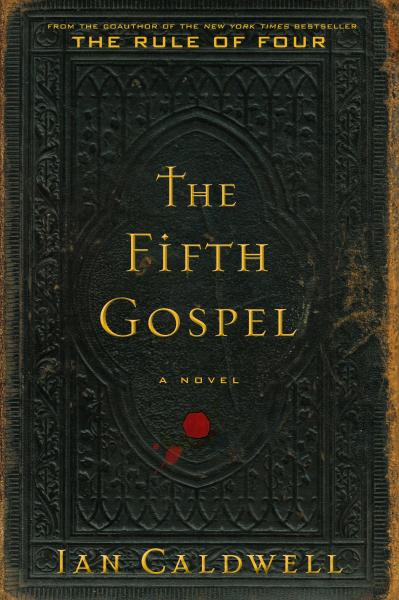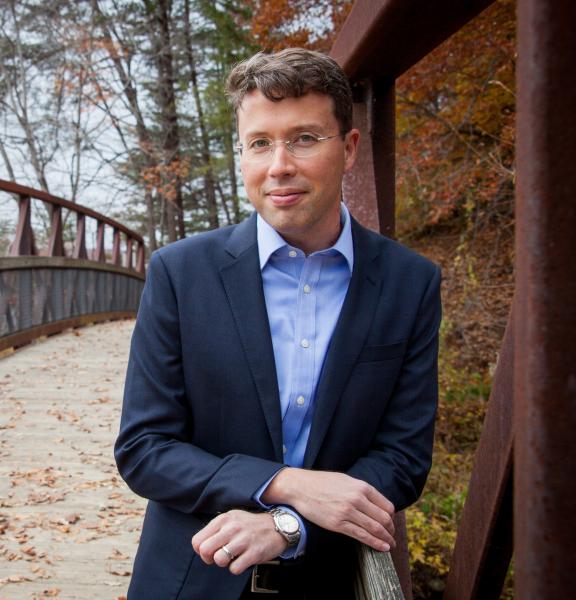A Q&A With Ian Caldwell, Author of March’s #1 Indie Next List Pick
 Booksellers who were eagerly awaiting a new novel from bestselling author Ian Caldwell have named The Fifth Gospel (Simon & Schuster), a work more than 10 years in the making, as the number one Indie Next List pick for March.
Booksellers who were eagerly awaiting a new novel from bestselling author Ian Caldwell have named The Fifth Gospel (Simon & Schuster), a work more than 10 years in the making, as the number one Indie Next List pick for March.
“One of the great mysteries of the Catholic Church, The Shroud of Turin, has inspired one of the great writers of our time to create this masterful thriller,” said Luisa Smith of Book Passage in Corte Madera, California. “Two brothers — Alex, a Greek Catholic priest, and Simon, a Roman Catholic priest — are drawn into the intrigue surrounding the Shroud and the origins of the Church following the murder of their friend Ugo, an eccentric curator obsessed with the Shroud who was preparing a major exhibit in the Vatican Gallery. Alex and Simon are dedicated brothers and priests, yet as different in temperament and faith as they are similar in conviction and loyalty. Caldwell unveils much about the world behind the Vatican walls, even as the intricate plot builds to a climax.”
Caldwell’s 2004 debut, The Rule of Four (Dial Press), co-authored with Dustin Thomason, was on the New York Times bestseller list for 49 weeks and was one of the top-selling books at indie bookstores that year.
In preparation for writing The Fifth Gospel, Caldwell said that he aimed for “an unprecedented level of realism” and backed up his efforts with immense amounts of research.
Bookselling This Week: The schism that established the Roman Catholic and the Eastern Orthodox Churches was solidified a thousand years ago, a rift that lays the groundwork for the mystery in The Fifth Gospel. Why did you choose to write about this divide? And why use the Shroud of Turin as the relic the story revolves around?

Ian Caldwell: These are the two biggest Christian Churches on earth — immense, ancient institutions — yet the relationship between them is spellbinding because it resembles the intimate, tragic bond that lingers between separated spouses trying to move beyond the pain of the past. So many wrongs were committed by one against the other, and since the schism, time has been much kinder to one than to the other. Whenever Europe was threatened by invasion, Eastern Europe and the Orthodox Church had to fight it off — sheerly as an accident of geography — while Western Europe and the Catholic Church were buffered, which means that part of the reason Catholicism became so successful during this millennium of separation is that she had an opportunity to thrive behind the shield of protection that Orthodoxy suffered to provide. Today, then, when they sit across from each other at the negotiating table, it’s deeply moving that Catholicism, as the Goliath of modern Christianity, wants so badly to reunite with Orthodoxy; yet it’s also heartbreaking to imagine how that gesture looks through Orthodox eyes.
The most thought-provoking part of all is that, considering the backdrop of our modern world, this old divorced couple (as we might call these institutions in secular terms) still agree they were meant to be together. Beneath this sometimes awkward and angry courtship, beneath the scars it forces back into the light, there abides a conviction that what God brought together long ago, no man should ever have separated. The Shroud of Turin is a perfect entrée into that relationship because, as Christianity’s most famous relic, it plays a mesmerizing double-role between Catholicism and Orthodoxy: holy relics spark many custody battles, but they also (as children often do) serve as a reminder of the beauty that once existed between two parents.
BTW: This is the second novel of yours that digs deep into a centuries-old, mysterious text: The Rule of Four looked at the Hypnerotomachia Poliphili, and The Fifth Gospel shares passages from the Diatessaron, the gospel that seeks to combine the texts of Mark, Matt, Luke, and John. What sparked your interest in researching and developing novels around these ancient works?
IC: Interpretation is an act of love. We are all fragments needing reassembly, codes waiting to be cracked, manuscripts that seem ordinary or impenetrable until the right person comes along and reveals us to be worthwhile or even extraordinary. This is a metaphor for romance that even young readers can identify with. But at the same time, close reading is threatening. Our identities — and the identities of the people we love most, especially the way we choose to see them — are self-created, and they don’t always hold up under rigorous inspection. The Rule of Four was about the first of these ideas (interpretation as romance) and The Fifth Gospel is about the second (interpretation as danger). Why I’m so attracted to this emotional territory I can’t say, though I’m also attracted to the process of interpretation, the relentless pursuit of answers, which echoes the way I experience life. This is probably why my novels not only center on old books, but take the literary form of mysteries.
Having said that, the Hypnerotomachia Poliphili and the Diatessaron sit at opposite extremes of my creative process. The Rule of Four was written around the Hypnerotomachia; the whole plot of the novel was structured, from the very first day, around a fictional “solution” to the text. The Diatessaron entered The Fifth Gospel only in the final two or three years of an 11-year writing process, and only because it encapsulated what I already knew to be the central concern of the novel: when faced with conflicting accounts of the truth (either about Jesus or about our loved ones), how do we decide what to believe?
BTW: The Fifth Gospel presents a deep understanding of the history and hierarchy of the Roman Catholic, Orthodox, and Eastern Catholic traditions, and also introduces the reader to fascinating details about Vatican City. How did you research and prepare to write a novel of this depth and breadth?
IC: The danger of writing a Vatican thriller is that if you aren’t careful, you just might succeed. I didn’t want The Fifth Gospel to be, as many books in the genre are, loose with the facts and wild with accusations. I wanted to offer the reader an unprecedented level of realism, a backstage pass to a place that has come to seem almost mythical in the popular imagination. Because I started this process as a religious agnostic, I knew I had my work cut out for me. So I boned up on Church history. I interviewed priests who had trained on Vatican soil, and asked them which books they had been assigned in seminary; then I read those books myself.
To understand how the Catholic Church thinks about the Shroud of Turin, I found audio recordings from an international conference where the papal custodian of the Turin Shroud had given a keynote address; then I contacted the papal custodian myself. I learned about Catholic law from an expert on secretive Church penal trials, and dug through more than a century of newspaper archives to compile a list of all Vatican crimes since 1870. To be able to envision every inch of the Vatican without retreating into make-believe, I gathered photos from papal photographers, out-of-print books, paparazzi, satellite images, even a man selling pictures he’d shot with a DSLR strapped to a drone that he’d flown over the pope’s walls. Every chance I got, I looked for more. I found a Roman priest willing to sell me, via eBay, a Vatican phone directory (which isn’t much bigger than the neighborhood phonebook of an average American subdevelopment). I collected Vatican maps dating back to the Renaissance. Vatican euro coins. I even had books shipped to me from the Vatican Library.
Perhaps most importantly, I interviewed priests and their wives within the Eastern Catholic churches — a relatively unknown part of Catholicism that retains the ancient practice of the married priesthood — in order to understand the perspective of my protagonist, a Greek priest with a five-year-old son. This complemented the hardest research I did in all the 11 years it took to write The Fifth Gospel: becoming a father myself. I started working on this novel before I was married, and now I have three sons. The experience of parenthood is, perhaps unexpectedly, at the very heart of this novel about what is seemingly the world’s most celibate place.
BTW: At several points in the novel, the lives of Alex and Simon seem to mirror the critical moments and trials from the history and texts of Christianity. Was it intentional to have certain aspects of the novel closely echo these stories and themes?
IC: The Christian view of history is fascinating because it’s both linear and circular: linear in the sense that God gives time a beginning and an end, and circular in the sense that our lives raise the same themes as the lives that came before us. Early in Church history, Christians needed to figure out the relationship between the Old Testament and the New Testament, and they came to the conclusion that events in Jewish history prefigure events in Christian history: Moses the lawgiver, for instance, is a precursor of Jesus the lawgiver; Isaac carrying the wood of his own sacrifice is a precursor of Jesus bearing his wooden cross toward his crucifixion. Ever since, Christians have read the Bible looking for repeated patterns, types, the fulfillment of one event by another. They have also searched for the echoes of these same events within their own lives, because the themes are permanent fixtures of the human condition; they don’t belong to us, we belong to them. In The Fifth Gospel, I tried to capture this mentality of seeing personal events in scriptural terms, and the correspondences are definitely not accidental!
BTW: Many of the characters in The Fifth Gospel display a form of unyielding devotion. What is the significance of the characters’ commitment to God or to family, especially in light of the many tests they endure?
IC: The Fifth Gospel is ultimately a story of life and faith under tremendous pressure. Its protagonist, Alex, is forced to the very edge of what he can accept as truth when everything he loves is threatened. Because of the setting, these aren’t just the emotional stakes of the novel; they’re the gateway into an excruciating moral calculus involving two powerful kinds of love. One love must be sacrificed for the other, but which? And how far should a man go to make that sacrifice? Our moral commitments give our decisions context and depth. In The Fifth Gospel they transform small moments of the protagonist’s life into meaningful ones, and big moments into a powerful, life-changing experience.

